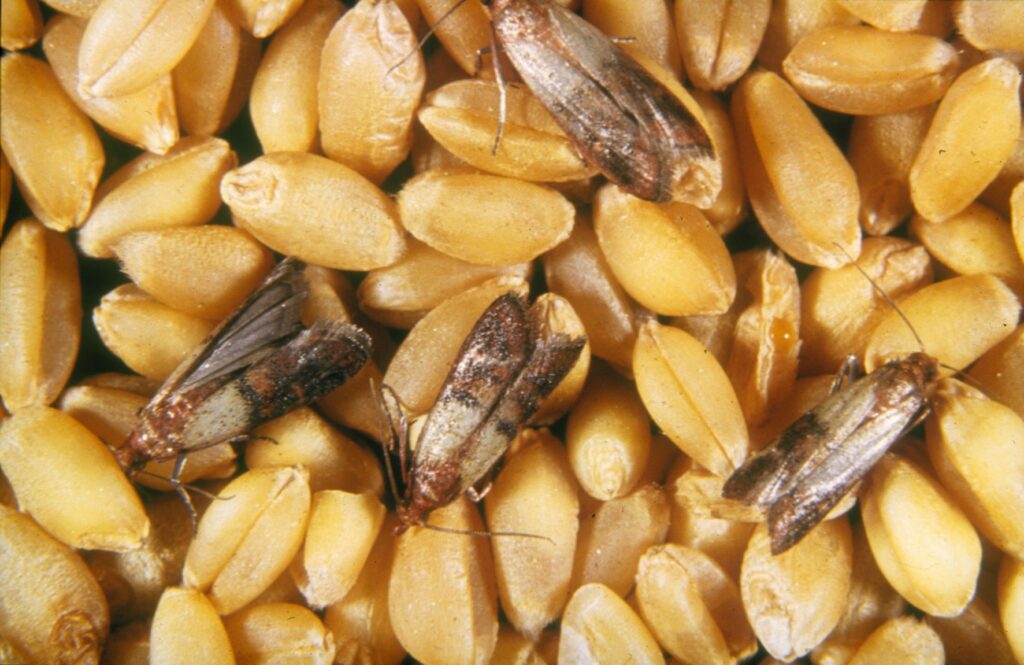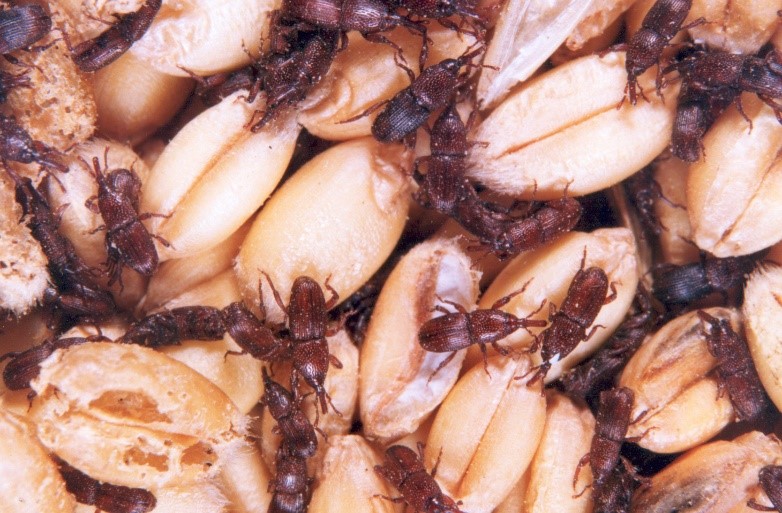It has been calculated that approximately one-third of all the grains produced globally is lost due to wastage every year. A major part of losses in agricultural production due to insects is the attack of insects on stored grains.
A huge variety of insects, rodents and roaches are known to infest such stored grains. They eat up grains, thereby reducing the quantity and more than that they selectively eat grain embryos rendering the grains infertile. Apart from eating, they also cause losses due to accumulations of their excretions, germs and parasites and also insect cadavers. The insect waste may also lead to the growth of different types of fungi and mould on the grains. All of these make the grains unfit for consumption.

These conditions are aggravated in regions with tropical climates as the moisture content of the grains in such regions are more, creating favourable conditions for insect populations to propagate and also for the moulds.

The feeding habits of storage insect pests are used to divide them into two classes: primary pests and secondary invaders. Primary pests are those that penetrate and infest intact grain kernels and have immature stages that can grow quickly within a grain kernel. Secondary invaders can’t get into sound grain, so they eat broken kernels, waste and grain that has been damaged by primary insect pests. The immature stages of these species are usually located outside of the grain. Both these pest types can cause significant damage and loss to the stored grains.
Some insights about the statistics of the scale of damage they cause is given below.
“62,000 tonnes of food grains damaged in FCI godowns in six years” – Development News
Around 62,000 tonnes of food grains, mainly rice and wheat, have been damaged in the last six years in the storage facilities of Food Corporation of India (FCI).
According to an RTI reply given by the Ministry of Consumer Affairs, Food & Public Distribution, 61,824 tonnes of food grains were damaged between 2011-12 and 2016-17, with the maximum damage of 24,695 tonnes reported in 2013-14. The RTI petition was filed by social activist Ram Gupta.
In 2016-17 (up to 1 March), a damage of 8,679 tonnes of food grains was reported, with Maharashtra topping the list of states with 7,963 tonnes. The FCI godowns in Madhya Pradesh, Bihar, Jharkhand, Haryana, Himachal Pradesh, Jammu & Kashmir, Uttarakhand, Arunachal Pradesh and Manipur did not report any damages. Himachal Pradesh has not reported any damages in the last six years
Sources said there are various reasons for the damage of food grains, including pest attacks, leakages in godowns, procurement of poor quality stocks, exposure to rains, floods and negligence on the part of the concerned persons in taking precautionary measures.
“Crops Lost to Rodent Infestation in India and Southeast Asia” – Victor V
The U.S. has a long way to go in erasing the problem, but crop losses due to rodent infestation are far worse on the other side of the world. Figures compiled by the Rice Knowledge Bank (RKB) show that in India, an estimated 25-30 percent of post-harvest grains are lost each year as a result of rodents. In terms of the nation’s stored food and seed grain market, the rodent issue has caused losses of more than $5 billion (in U.S. money). However, according to some analysts, these figures are conservative estimates that actually seem miniscule for a nation with 2.5 billion rats, each one of which could potentially cause $10-15 billion (U.S. dollars) in damages.
Those higher numbers are based on the daily food consumption of rodents. What do rodents eat? A lot. Rats, for instance, consume seven percent of their own body weight on a daily basis, while mice eat up to 20 percent.
“FCI godowns home to insects, say villagers” – The New Indian Express
The residents of villages in Sramasaktinagar and China Mushidiwada are having sleepless nights due to insects swarming the area at a 5 kms radius from the Food Corporation.
The insects coming from the godowns especially during evenings have become a nuisance to the villagers. The insects invade every part of the household and food material resulting in people suffering from rashes. Also, students in the village are unable to pursue their studies after sunset.
When the rice stock is being unloaded from the railway wagons, all the insects are coming out from the godown and going into the villages, he lamented.
The common chemical pest control methods used like insecticides, rodenticides, fumigation, etc. are completely out of question to be used around food and foodgrains. Rat baits and glue boards also prove to be useless because that would still compromise the edibility of the food grains.
C Tech Corporation has developed the perfect solution to this problem. Our product, Combirepel™, is a non-toxic, non-hazardous animal, rodent, termite, insect, bird and animal repellent which has been designed for various polymeric applications as well as natural materials. It is a unique blend of green chemistry and smart technology which acts as an effective repellent and at the same time guarantees safety to the environment, plants, animals and fragile ecosystem. Our product works on the mechanism of repellence.
Our masterbatch is compatible with PVC, PE, LDPE, MDPE and HDPE base polymers. It can be incorporated while manufacturing all types of wraps and films, floating row covers, mulch films, grain bags, silage sheets and bags, etc. Incorporating the masterbatch into the base polymer during its extrusion process will make the final application pest resistant.
Because of our products being 100% natural and eco-friendly, they can be safely used around food and food products. They cause no harm to any organisms, us humans and the environment. The products also have a very high active life. They are thermally stable and do not degrade on exposure to heat and sunlight. It does not volatilize and does not degrade the soil. It is EU-BPR, RoHS, RoHS2, RoHS3, REACH, APVMA, NEA compliant and FIFRA exempted.
Contact us at technical.marketing@ctechcorporation.com to keep the pests away.
Also, visit our websites:
http://www.ctechcorporation.com/
Follow our Facebook pages at:
1] https://www.facebook.com/Combirepel-411710912249274/
2] https://www.facebook.com/Termirepel-104225413091251/
3] https://www.facebook.com/Rodrepel-120734974768048/
Follow us on our Twitter pages at:
1] https://twitter.com/rodrepel

